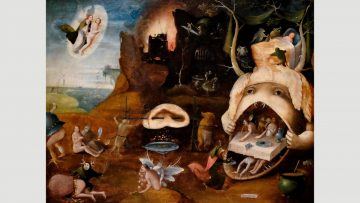Cath Pound in BBC:
 Dreams have fascinated philosophers and artists for centuries. They have been seen as divine messages, a way of unleashing creativity and, since the advent of psychoanalysis in the 19th Century, the key to understanding our unconscious. As so many of us have been experiencing unusually vivid dreams in recent weeks, it seems an opportune moment to explore the way in which they have been understood and depicted throughout the centuries. In doing so we may even find some intriguing parallels with our own experiences. But why are we dreaming so vividly now? “We’re in a new situation so there’s new emotions to process,” says psychotherapist Philippa Perry, who was inundated with replies when she recently asked her followers to send her their dreams on Twitter. We make up narratives to make sense of those feelings that in dream manifest themselves “not straightforwardly but in metaphors”, she explains.
Dreams have fascinated philosophers and artists for centuries. They have been seen as divine messages, a way of unleashing creativity and, since the advent of psychoanalysis in the 19th Century, the key to understanding our unconscious. As so many of us have been experiencing unusually vivid dreams in recent weeks, it seems an opportune moment to explore the way in which they have been understood and depicted throughout the centuries. In doing so we may even find some intriguing parallels with our own experiences. But why are we dreaming so vividly now? “We’re in a new situation so there’s new emotions to process,” says psychotherapist Philippa Perry, who was inundated with replies when she recently asked her followers to send her their dreams on Twitter. We make up narratives to make sense of those feelings that in dream manifest themselves “not straightforwardly but in metaphors”, she explains.
Albrecht Dürer’s Dream Vision (1525) is the first known depiction in Western art of an artist’s personal dream. The watercolour, seemingly hastily produced on waking, shows a deluge of water descending from the sky to engulf him. “I awoke trembling in every limb and it took a long time for me to recover,” he noted. Perry says that although her training taught her there was no such thing as a dream dictionary, decades of practice have shown her that “certain objects usually stand for a certain thing”, and “if somebody dreams about water that is usually about feelings”. To her, it sounds as if Dürer was “drowning in feelings”, and although of course she cannot be sure what those feelings were, “most of us, whether we admit it or not, or are ignorant of it when awake, fear annihilation and oblivion”, she says. Perhaps it is unsurprising that many of the dreams Perry was sent on Twitter also involved people being engulfed with water, although the woman who dreamt she was surfing on a tsunami was clearly dealing with her emotions better than Dürer.
More here.
